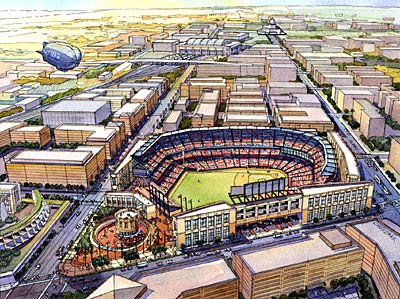Once again, DC bucks the trend (baseball)
 Note the State of Virginia license plate.
Note the State of Virginia license plate.According to the current issue of Governing Magazine, "Skybox Skeptics: It’s getting harder and harder for baseball teams to wangle public money for new stadiums." From the article:
Local and state governments are putting up increasing resistance to the idea of paying for new baseball stadiums. The Minnesota Twins have spent a decade trying to win public funds for a new ballpark but have been rebuffed by the legislature every time, most recently last year. The Marlins began seeking new suitors after the Florida legislature refused to contribute state money to build the team a new home. And the District of Columbia’s City Council has already demanded, and won, multiple renegotiations of the deal that brought the Washington Nationals to town last year.
Public funding for stadiums has not exactly dried up. Since 2000, the average new major league baseball stadium has been built with 54 percent public funds, compared with 55 percent for new professional football stadiums. But the trend clearly seems to be moving in the other direction. The one ballpark completed in the past two years, in St. Louis, was built almost entirely with private money.
Communities are playing hardball with the national pastime largely as a result of two developments. First, elected officials have begun to accept academic research showing that the economic benefits of subsidizing stadiums doesn’t justify the costs. Second, threats by team owners to leave town are losing their potency because it is widely known that there are very few attractive markets for them to move to. Against this backdrop, baseball’s supporters may have to turn to a different argument: that the sport is worth subsidizing simply because it is integral to a community’s quality of life....
Stadium financing is a subject Governing has visited frequently. Here is a selection of articles and commentary from recent years:
· "Ballpark Dreaming" (November 2004)
· "Throwaway Stadium" (January 2000)
· "The Stadium Trap" (May 1998)
· "Home Teams Forever" (March 1996)
 An architect that I met last week with far better connections than I claims he was shown drawings of the stadium plan and that it is quite beautiful.
An architect that I met last week with far better connections than I claims he was shown drawings of the stadium plan and that it is quite beautiful.



0 Comments:
Post a Comment
<< Home